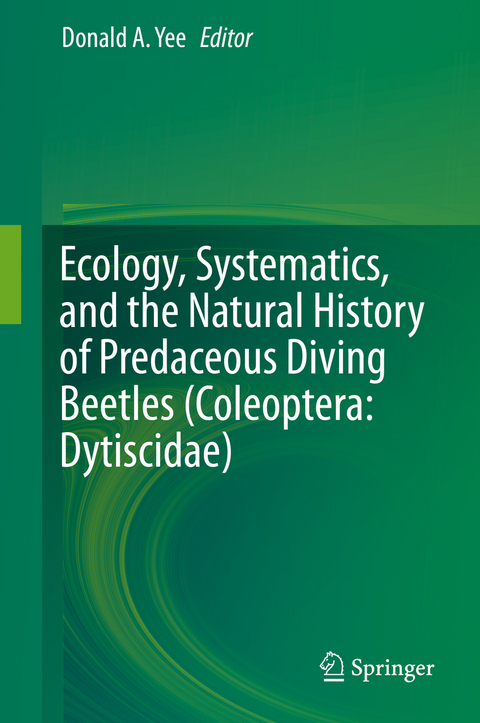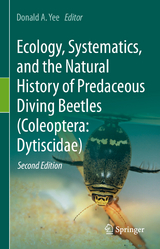
Ecology, Systematics, and the Natural History of Predaceous Diving Beetles (Coleoptera: Dytiscidae)
Springer (Verlag)
978-94-017-9108-3 (ISBN)
- Titel erscheint in neuer Auflage
- Artikel merken
Although his primary research focus involves medically important container mosquitoes, he is broadly a community ecologist who has a strong, broad background in invertebrates and aquatic habitats. He has focused most of his research efforts on mosquitoes, in part because this group provides an excellent model system to explore topics across many levels of ecological organization, from individuals, to population, to communities. His specific interests lie in examining how individual species traits, such as feeding behavior, habitat selection, dispersal and oviposition decisions affect species interactions and in linking how the outcomes of these interactions affect patterns of species diversity and invasion success. This work has important implications for public health, as findings of his work can offer insights into the factors that control the distributions of medically important mosquitoes.
Title: Ecology, Systematics, and Natural History of Predaceous Diving Beetles (Coleoptera: Dytiscidae)
Title Page
Table of Contents
Dedication
Foreword
Preface
1. An introduction to the Dytiscidae: their diversity, historical importance, cultural significance, and other musings
1.1 Dytiscids past and present
1.2 Nature red in tooth and claw and mandible
1.3 Cultural notes
1.4 Final words
2. Bridging ecology and systematics: 25 years of study of larval morphology of world Dytiscidae
2.1. Introduction
2.2 General Morphology of Dytiscidae Larvae
2.3. Chaetotaxy Analysis: Methodological Approach
2.4. Ground Plan Pattern of Primary Setae and Pores of the Dytiscidae
2.5 Larval Chaetotaxy and Ontogeny
2.6 Bridging Ecology and Systematics
2.7 Summary and future directions
3. The phylogeny and classification of predaceous diving beetles
3.1 Introduction
3.2 Material and Methods
3.3 Results
3.4 Discussion
3.5 Diving beetle phylogeny and classification
3.6 Family-group classification of Dytiscidae Leach, 1815
3.7 Future directions
4. Morphology, anatomy, and physiological aspects of dytiscids
4.1 External morphology
4.2 Internal anatomy and physiology
4.3 Future directions5. Predaceous diving beetle sexual systems
5. Predaceous diving beetle sexual systems
5.1 Introduction
5.2 Sexual variation
5.3 Dytiscid sexual systems
5.4 Summary
5.5 Future directions
6. Chemical ecology and biochemistry of Dytiscidae
6.1. Chemical ecology of freshwater organisms
6.2. Chemical senses
6.3. Intraspecific interactions: Sex-Pheromones
6.4. Interspecific interactions
6.5. Dermal glands, epicuticular lipids, and body coloration by pigments
6.6. Microorganisms and dytiscids
6.7. Future directions7. Habitats
7.1 Defining habitats
7.2 Classifying habitats
7.3 Abiotic habitat conditions
7.4 Biotic interactions
7.5 Plant-dytiscid relationships
7.6 Habitat specificity
7.7 Future Directions
8. Predator-prey interactions of dytiscids
8.1 Introduction
8.2 What do dytiscids eat?
8.3 Selective predation and effects on community attributes
8.4 Cannibalism and Intraguild Predation
8.5 Non-consumptive effects of dytiscid predation
8.6 Dytiscids as predators of vector and nuisance species
8.7 Environmental constraints on predation
8.8 Dytiscids as prey
8.9 Future Directions
9. Dispersal in Dytiscidae
9.1 Introduction
9.2 The evolution, maintenance, and consequences of dispersal
9.3 Consequences of dispersal
9.4 On flight and wings and flightlessness
9.5 Proximate drivers of dispersal and how to find water
9.6 The macroecology of movement in predaceous diving beetles
9.7. Future directions – where do we (and the beetles) go from here?
10. Community patterns in dytiscids
10.1 An introduction to natural communities
10.2 Random vs. non-random distributions
10.3 Ecological similarity
10.4 Dispersal
10.5 Phylogenetic community composition
10.6 Summary and Future Directions
11. The conservation of predaceous diving beetles: knowns, unknowns and anecdote
11.1 Introduction
11.2 Dytiscidae as a group worthy of conservation
11.3 The causes of loss
11.4 Drainage
11.5 Pollution
11.6 Encroachment
11.7 Climate change
11.8 Globalization, and the fourth horsemen of the apocalypse
11.9 Types of conservation
11.1 0 European Conventions – including a case-study in conservation legislation and
its consequences
11.11 Popularity, biodiversity and ecosystem services
11.12 Global Lists
11.13 Dumbing-down
11.14 The way ahead – “passive conservation” and the possible pitfalls of connectivity
1.15 Future directions
Index
| Zusatzinfo | 9 Tables, black and white; 90 Illustrations, color; 58 Illustrations, black and white; XVIII, 468 p. 148 illus., 90 illus. in color. |
|---|---|
| Verlagsort | Dordrecht |
| Sprache | englisch |
| Maße | 155 x 235 mm |
| Gewicht | 9397 g |
| Themenwelt | Naturwissenschaften ► Biologie ► Evolution |
| Naturwissenschaften ► Biologie ► Ökologie / Naturschutz | |
| Naturwissenschaften ► Biologie ► Zoologie | |
| Schlagworte | dytiscid • food web • Freshwater • Predator • Systematics |
| ISBN-10 | 94-017-9108-2 / 9401791082 |
| ISBN-13 | 978-94-017-9108-3 / 9789401791083 |
| Zustand | Neuware |
| Haben Sie eine Frage zum Produkt? |
aus dem Bereich



